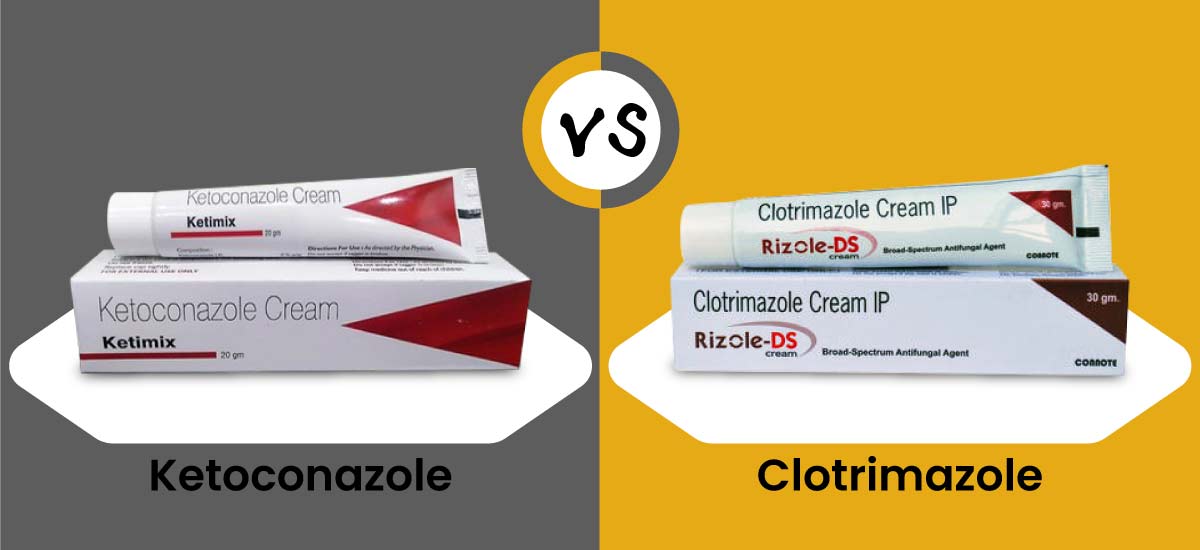Ketoconazole is the medication that treats fungal infections whereas, Clotrimazole is the medication that treats yeast infection and is not suitable to treat fungal infection.
What Is Ketoconazole?
Ketoconazole is an antifungal medication sold under the brand name Nizoral that treats fungal infections caused due to fungus. Ketoconazole is an anti-androgen medication that is remedial to the conditions, namely, cutaneous candidiasis, dandruff, pityriasis Versicolor, seborrheic dermatitis (Cantilena, L.R., 1993).
What is Clotrimazole?
Clotrimazole is an FDA-approved medication sold under the brand name Lotrimin that is primarily used to treat infections such as yeast infections in the vaginal area, oral thrush, diaper rash, pityriasis Versicolor, and ringworm infections such as athlete's foot and jock itch (Gallagher, H.C., 2014).
How Does Ketoconazole Work?
Clotrimazole kills the fungus (yeast) that is the source of the infection. Clotrimazole kills fungus by causing holes in its cell membrane to emerge, allowing the components to escape. The fungus is killed, and the infection is treated (Müller, R.H., 2005).
How Does Clotrimazole Work?
Clotrimazole kills the fungus (yeast) that is the source of the infection. Clotrimazole kills fungus by causing holes in its cell membrane to emerge, allowing the components to escape. The fungus is killed, and the infection is treated.
Ketoconazole: Form And Strength
- Form: This drug comes in the form of a tablet.
- Strength: 200mg
Clotrimazole: Form And Strength
- Form: cream, ointment and also available as a troche.
- Strength: lozenge 10mg
- troche 10mg
Ketoconazole: How To Take It?
Ketoconazole is available as a pill that can be swallowed. It is typically taken once per day. Ketoconazole should be taken at the same time each day. Follow the medication as directed carefully, and if there is anything you don't understand, consult your veterinarian or pharmacist. Ketoconazole should be taken exactly as prescribed (D.A.J., 1981).
Clotrimazole: How To Take It?
It is generally taken five times a day for 14 days to treat yeast infections. It is commonly taken three times a day to prevent yeast infections. The course of the preventative treatment is determined according to one's condition.
Clotrimazole is available over the counter, you can purchase Clotrimazole online from a certified online pharmacy, but before taking these medications consult your healthcare provider.
Ketoconazole: Dosage
- The dosage for fungal infection:
- Adults: 200-400 mg orally per day
- Children under the age of two: Safety and efficacy have yet to be determined.
Clotrimazole: Dosage
- The troche (lozenge) should dissolve gradually. One troche is given five times a day for 14 days.
- For 7 days, the vaginal cream is injected by the applicator once daily, ideally at night.
- For 7 days, the 100 mg vaginal suppository is injected once daily, ideally at bedtime.
- The 200 mg vaginal suppository is administered once a day, ideally before night, for three days.
Ketoconazole: Side Effects
| Common Side Effects |
| Nausea or vomiting |
| Foul smelling |
| Rash |
| Hive |
| Fever Chills |
Clotrimazole: Side Effects
The side effects of this medication can be common or adverse. In any case, consult the physician immediately.
| Adverse side effects | Common side effects |
| Loss of hair | Vomiting |
| Headache | Nausea |
| Dizziness | Itching |
| Allergy | Rash on the skin |
Ketoconazole: Who Should Not Take It?
- Ketoconazole can injure your liver severely, requiring a liver transplant or perhaps death. If you noticed any symptoms of liver damage, such as nausea, vomiting, stomach discomfort, urine, clay-colored stools, or jaundice, call your doctor (yellowing of the skin or eyes)
- Ketoconazole might potentially be dangerous to your heart. If you develop fast or pounding heartbeats, shortness of breath, or abrupt dizziness, call your doctor straight away (Borelli, D., 1980).
Clotrimazole: Who Should Not Take It?
- Don't consume this medication if you are allergic to it
- Do not take the medicines if you are suffering from any liver or heart conditions.
- Consult the doctor before taking the medication
Ketoconazole: Medical Conditions
- Overdose:The side effects overdosed on this medication can lead to side effects nausea or vomiting, feeling tired, stomach pain or tenderness, dark urine, or light-colored stools. You overdosed on Ketoconazole, contact your doctor or your local Poison Control Center straight away, or seek emergency medical help.
- Alcohol:Do not consume alcoholic beverages. It's possible that you'll have dangerous side effects.
- During pregnancy:Animal reproduction studies have revealed an unfavorable effect on the fetus, and there are no appropriate and well-controlled trials in humans. However, possible benefits may justify the use of the medicine in pregnant women despite potential risks, according to the US FDA pregnancy category C.
Clotrimazole: Medical Conditions
- Overdose: If overdosed, it can lead to side effects, namely burning, stinging, swelling, irritation, redness, pimple-like lumps, soreness, or peeling. I overdosed on Clotrimazole. Contact your doctor or your local Poison Control Center straight away, or seek emergency medical help.
- Alcohol: Alcohol can be consumed when taking Clotrimazole.
- During pregnancy: Clotrimazole is generally thought to be safe for use by pregnant women. It is suggested that you insert the pessary using your fingers rather than the applicator supplied if you are treating vaginal thrush during pregnancy.
Study: Ketoconazole v/s Clotrimazole
Research: This study was conducted by the Department of Dermatology, University Clinic of the RWTH Aachen, Germany.
Aim: In a double-blind, randomized study, the efficacy of two topical cream formulations containing Clotrimazole 1 percent and Ketoconazole 2 percent, respectively, were clinically evaluated for a 28-day treatment of interdigital tinea pedis in 106 patients.
Conclusion: Both Clotrimazole and Ketoconazole may successfully treat tinea pedis within 28 days of treatment. Once-daily Clotrimazole is similarly effective as twice-daily Ketoconazole, with favorable effects on the disease's most bothersome symptoms.
Synopsis: Ketoconazole and Clotrimazole are both effective medications, as proved in the study. Both the medicines treat infections ranging from yeast infection to candidiasis; however, Clotrimazole does not treat other fungal infections. In any case, confirm with the doctor regarding any history of medical problems to take suitable precautions or can be lethal. Do not consume any of these medications without the doctor's prescription or consultation.



 07 Jan 2022
07 Jan 2022


